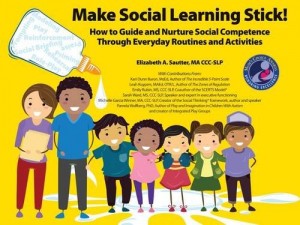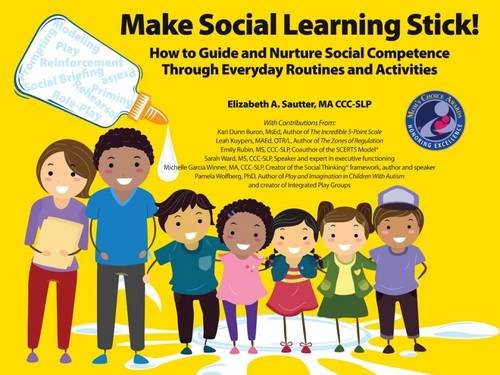 My dear friend Laura has the coolest job in the world – she’s a book publicist. She’s also a fellow “sensory mom” and knows what we’ve been through with L.’s complex neurology. So when Laura messages me about a new book she’d love me to read and review, I know it’s going to be something I have to check out.
My dear friend Laura has the coolest job in the world – she’s a book publicist. She’s also a fellow “sensory mom” and knows what we’ve been through with L.’s complex neurology. So when Laura messages me about a new book she’d love me to read and review, I know it’s going to be something I have to check out.
Make Social Learning Stick by Elizabeth Sautter isn’t so much a “book” in the way you might expect. I experienced it more as a sort of field guide, a curriculum model for parenting – it’s full of colorful illustrations and charts, each helping to explain a different set of techniques that can help kids more effectively learn and retain the messages around social interactions that will set them up for greater interpersonal success. It’s not necessarily a book only for the parents of kids who might struggle with social skills because of deficits like SPD, NVLD, ASD or Tourette’s; typically developing kids can also benefit from the activities and conversations described in the book. But if you’ve got a child with one of those challenges, or any other specified or unspecified social skills challenge, then Make Social Learning Stick is a great tool to add to your arsenal.
In our home, I think J. and I walk a fine line between wanting to help and support L. in whatever ways possible, and not wanting to overwhelm and smother him with “therapeutic activities” and interventions. (In truth, we are incredibly fortunate to have this option. L. has challenges, yes, but he is also extremely high-functioning in almost every way, so his need for intensive therapies and interventions at this point in his life is much less than it could be – and sometimes has been.) At this point in his life, we see that he is happier, less anxious, and makes greater strides when we can treat him largely as a typical second-grader and just sort of “slip in” the therapeutic models where they make sense. It means that we’re not actively pursuing “therapies” right now, but we’re using everyday activities as teachable moments and structuring the way we model, teach, and communicate about tasks and expectations to help set him up for (hopeful) long-term success. So when I looked through Make Social Learning Stick the first time, I was happy to see that it really is a book about integrating practical therapeutic ideas and techniques into everyday life. Far from being a regimen to follow, it provides ways to think about ordinary interactions and social situations that can help parents frame them as teaching opportunities for kids, and set up the encounters to build success.
Some of the suggestions and activities in the book were a bit younger or overly simplistic given where L. is at the moment, but much of that is because we were fortunate to have him in both intensive outpatient therapy and a phenomenally tuned-in full day preschool/Pre-K program when he was little, so we’re probably starting with an advantage that many families don’t have. However, I marked several techniques that I want to try with him and we’ve started incorporating some of them into our daily lives to see how they affect L.’s functioning. Because his NVLD profile means that he responds best to verbal and conversational techniques, we started using the dinner table as a place to work with some of the book’s concepts.
Ordinarily, we might ask questions at the table like “What did you learn during library today?” or “Tell me a story about recess.” I’ve also asked specific questions like “Did any friends or classmates say something funny today? Did anything weird or gross happen in class?” and other descriptive items to get the conversation flowing. But Make Social Learning Stick gave me a new concept to work with: Adding to the fun. In a nutshell, the idea is that we can improve kids’ play and social interactions with others by asking them to be aware of which behaviors (either their own or others’) ADD to the fun, and which behaviors TAKE AWAY FROM the fun. So after introducing the concept to the boys, I started kicking off dinner table conversations like this:
“Did you add to the fun at recess today, or did you take away from the fun?”
“What did you do today that added to somebody’s fun?”
“Did anyone do something today to add to your fun? Did anyone do something to take away from the fun?”
I wasn’t sure how it would work, but within a few days both of my boys were contributing concrete examples in response to these kinds of questions, so I started dropping L. off at school with a whispered reminder: “Have a great day! Don’t forget to add to the fun!” I knew the concept was sinking in when one night, not long after we’d started talking about it, I was playing a game with P. while L. worked at his desk in the next room. P. was showing poor sportsmanship, and as I struggled to help him get his behavior under control to return to the game, L. suddenly hollered from his desk, “P.! You’re not adding to the fun! Add to the fun!”
With that success under our belts, we’ve continued to hammer away at “adding to the fun,” but I’ve also started to build in another, more challenging concept from the book. Make Social Learning Stick suggests that explicitly helping kids to understand that others will have thoughts about them in each moment, and that they will have thoughts about others in turn, can be a step towards interpreting and even predicting others’ feelings and actions in social interactions. With that in mind, I’ve started to turn our dinner conversations towards “kinds of thoughts.” “So what kind of a thought do you think that friend was having about you?” I’ll ask when L. complains that he had a spat with a classmate. Or, “What were you thinking about that person right then?” as he describes watching something happen on the playground. When we problem-solve in advance (something he does frequently to help himself manage potentially challenging relationships or situations), I’ll say, “That’s one idea about how to solve your problem. Let’s test it out. If you do that, what kind of thoughts do you think so-and-so will have about you?” We’ve found that predicting how others might think about his actions or words has helped him to better plan how to work through situations that are uncomfortable for him, and reflecting on his own thoughts about classmates and their thoughts about him after an interaction like playing together at recess has made it easier for him to understand social situations and to join in more comfortably.
Make Social Learning Stick is a strong, practical tool for parents, and I think teachers and other adults who are actively involved with the care of children – particularly those with social skills challenges – could also benefit from reading and using some of its techniques. There are hands-on activities in the book that we haven’t even tried yet, but I can already predict that some of the higher-level journaling and reflecting could be very powerful for L. We’re looking forward to continuing to work with the book, and bringing more of its concepts to our dinner table conversations to help both of our boys learn and grow.
Disclosure: I was provided with a copy of “Make Social Learning Stick” to facilitate this review, but received no other compensation. My thoughts and opinions are solely my own.


Leave A Comment